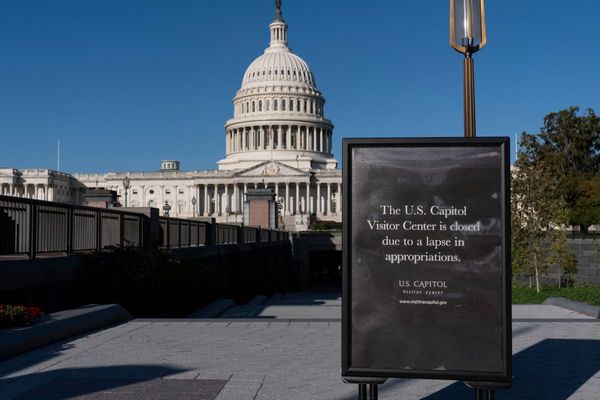Mind your step ... Nathan Coley's Untitled (Threshold Sculpture), seen in Liverpool
for the first time. Photograph: Christopher Furlong/AFP/Getty
I have just stumbled into the media preview for the 2007 Turner Prize exhibition. Literally so, as someone has rather inconsiderately placed a raised strip of wood, like a railway sleeper, across the entrance. A gallery steward comes hurrying up.
"You mustn't stand on that," she says. "I'm not standing on it," I protest, "I just tripped over it." "You're not supposed to stand on it." "Well, what's it doing there, then?" "It's an art work. You have to stand on one side or the other."
The health-and-safety hazard, more properly known as Untitled (Threshold Sculpture), is part of Nathan Coley's exhibit which, as a curator busily explains to a roomful of cameramen, journalists and sound crews, is all about the power inferred through architecture and public space. The assembled critics seem bleary and unimpressed, as well they might, most of them having taken an 8am train out of Euston (unlike me, who came from York via the Transpennine Express). Hosting the Turner is Liverpool's biggest warm-up event for 2008 so far; but for those on the London press train it's a long way to come to inspect work which is neither new, exclusive to Liverpool nor even the pieces for which the artists were nominated in the first place.
And a crowded media call never provides the best conditions to actually look at any art: Zarina Bhimji's melancholic photographs of her travels around Uganda require considered, meditative contemplation; yet it's very difficult to wander around without intruding into some TV crew's shot of their correspondent pretending to look at the pictures. I give up on the photographs and go and watch Bhimji's film of an East African hemp factory, which is a non-narrative documentary full of poetically lingering shots of sisal threads fluttering in the breeze. It hardly needs pointing out that if Bhimji collects the £25,000 top prize it will be money for old rope.
Mike Nelson is famed for creating mysterious, labyrinthine environments and his suite of white cubicles and corridors creates quite a bottleneck of critics waiting to peer through the little holes that Nelson has punched through the walls. A curator informs a nodding delegation of foreign press that a title for the piece only emerged two days ago "that is far too long for me to remember at this time". I wonder how many European papers will solemnly report on Nelson's enigmatic new installation Far Too Long For Me To Remember At This Time.
Mark Wallinger is odds-on favourite to win for his memorable reconstruction of Brian Haw's one-man anti-war protest in Parliament Square. Needless to say, that piece isn't actually here: the whole point being that the main hall of Tate Britain was just inside the one-kilometre exclusion zone imposed by the police. Recreating it 200 miles outside the exclusion zone wouldn't have quite the same impact; instead the Liverpool show features Wallinger's film of himself ambling around Berlin dressed in a bear costume. It's apparently something to do with fairytale archetypes and a comment on national identity in the post-Cold War era.
It's uncommon for a Turner Prize show to include the actual work which received the judges' nomination, but this year there is an exception. Nathan Coley's large illuminated billboard, originally sited on the Isle of Bute, has been re-installed at Tate Liverpool. Constructed from glowing bulbs on a scaffolding frame, the sign reads THERE WILL BE NO MIRACLES HERE. You can't accuse of the organisers of the Turner Prize exhibition 2007 of failing to spell it out any clearer than that.







